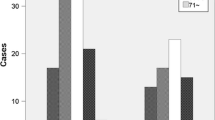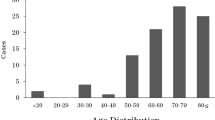Abstract
To investigate the expression of AFB1 gene in isolates obtained from corneal scrapping samples from keratitis patients and to correlate the quantity of AFB1 to the severity of keratitis. An observational study was undertaken in Medical Microbiology and Immunology department, Mansoura University, Egypt, over corneal scrapping samples that were cultured aiming to isolate fungal causes of infective keratitis followed by AFB1 gene detection in Aspergillus flavus isolates by nested PCR then quantitation of the toxin by TLC. Out of 843 corneal scrapping samples collected from patients with infective keratitis, positive fungal growth was identified in 277 cases (32.9%). A. flavus was the commonest fungal agent isolated in 93 cases (33.6%). The AFB1 toxin–encoding gene was detected in 63.4% of A. flavus isolates. There was a positive correlation between the quantity of produced AFB1 toxin and the degree of severity of keratitis (P value < 0.0001*). Aspergillus flavus was the most common cause of fungal keratitis, with the AFB1 toxin–encoding gene detected in more than half of the isolates. A significant correlation between the degree of severity of keratitis and the quantity of produced AFB1 toxin was detected. Therefore, exploring presence or absence of AFB1 toxin is important for the clinicians in their diagnostic assessment and selection of proper treatment choices.

Similar content being viewed by others
Abbreviations
- A. flavus :
-
Aspergillus flavus
- AFB1:
-
Aflatoxin B1
- Nested PCR:
-
Nested polymerase chain reaction
- TLC:
-
Thin-line chromatography
References
Szczotka-Flynn LB, Pearlman E, Ghannoum M (2010) Microbial contamination of contact lenses, lens care solutions and their accessories: a literature review. Eye Contact Lens 36:116–129
Thomas PA (2003) Fungal infections of the cornea. Eye 17:852–862
Eaton DL, Gallagher EP (1994) Mechanisms of aflatoxin carcinogenesis. Annu Rev Pharmacol Toxicol 34:135–172
Ehrlich KC, Yu J, Cotty PJ (2005) Aflatoxin biosynthesis gene clusters and flanking regions. J Appl Microbiol 99:518–527
Leema G, Kaliamurthy J, Geraldine P, Thomas PA (2010) Keratitis due to Aspergillus flavus: clinical profile, molecular identification of fungal strains and detection of aflatoxin production. Mol Vis 16:843–854
Chang PK (2004) Lack of interaction between AFLR and AFLJ contributes to nonaflatoxigenicity of Aspergillus sojae. J Biotechnol 107:245–253
Hara S, Murakami H, Ohba T, Sugama S (1973) Studies on the mycological characters of aflatoxin-producing strains belonging to the A. flavus group. E. Production of moldy rice containing aflatoxin from rice and saki brewing with the moldy rice. Rep Res Inst Brew 145:13–18
Ahn M, Yoon K, Ryu S, Cho N, You I (2011) Clinical aspects and prognosis of mixed microbial (bacterial and fungal) keratitis. Cornea. 30:409–413
Jones DB (1981) Decision-making in the management of microbial keratitis. Ophthalmol. 88:814–820
Kumar M, Mishra NK, Shukla PK (2005) Sensitive and rapid polymerase chain reaction based diagnosis of mycotic keratitis through single stranded conformation polymorphism. Am J Ophthalmol 140:851–857
Bintvihok A, Treebonmuang S, Srisakwattana K, Nuanchun W, Patthanachai K, Usawang S (2016) A rapid and sensitive detection of aflatoxin-producing fungus using an optimized polymerase chain reaction (PCR). Toxicol Res 32(1):81–87
Przyblylski W (1975) Formation of aflatoxin derivatives on thin layer chromatographic plates. J Assoc Off Anal Chem 58:163–164
Nabney J, Nesbitt BF (1965) A spectrophotometric method for determining the aflatoxins. Analyst (Lond) 90:155–160
Dóczi I, Gyetvai T, Kredics L, Nagy E (2004) Involvement of Fusarium spp. in fungal keratitis. Clin Microbiol Infect 10:773–776
Zaki SM, Denning DW (2017) Serious fungal infections in Egypt. Eur J Clin Microbiol Infect Dis 36(6):971–974. https://doi.org/10.1007/s10096-017-2929-4
Badawi AE, Moemen D, El-Tantawy NL (2017) Epidemiological, clinical and laboratory findings of infectious keratitis at Mansoura Ophthalmic Center. Egypt Int J Ophthalmol 10(1):61–67
Khater MM, Shehab NS, El-Badry AS (2014) Comparison of mycotic keratitis with nonmycotic keratitis: an epidemiological study. J Ophthalmol 2014:254302
Bharathi MJ, Ramakrishnan R, Vasu S, Meenakshi R, Palaniappan R (2003) Epidemiological characteristics and laboratory diagnosis of fungal keratitis. A three-year study. Indian J Ophthalmol 51:315–321
Farrell S, McElnea E, Moran S, Knowles S, Murphy CC (2017) Fungal keratitis in the Republic of Ireland. Eye (Lond) 31(10):1427–1434
Gajjar DU, Pal AK, Ghodadra BK, Vasavada AR (2013) Microscopic evaluation, molecular identification, antifungal susceptibility, and clinical outcomes in fusarium, Aspergillus and, dematiaceous keratitis. Biomed Res Int 2013:605308
Singh G, Manikandan P, Bhaskar M, Revathi R, Narendran K, Kour A, Narendran V (2006) Multivariate analysis of childhood microbial keratitis in South India. Ann Acad Med Singap 35:185–189
Bharathi MJ, Ramakrishnan RR, Meenakshi RR, Mittal SS, Kumar CS, Srinivasan MM (2006) Microbiological diagnosis of infective keratitis: comparative evaluation of direct microscopy and culture results. Br J Ophthalmol 90:1271–1276
Levin RE (2012) PCR detection of aflatoxin producing fungi and its limitations. Int J Food Microbiol 156:1–6
Selvam et al. (2014) Biosci Biotech Res Asia 11(2):479–490
Moore GG, Singh R, Horn BW, Carbone I (2009) Recombination and lineage specific gene loss in the aflatoxin gene cluster of Aspergillus flavus. Mol Ecol 18:4870–4887
Leema G, Chou DS, Jesudasan CA, Geraldine P, Thomas PA (2011) Expression of genes of the aflatoxin biosynthetic pathway in Aspergillus flavus isolates from keratitis. Mol Vis 17:2889–2897
Flaherty JE, Payne G (1997) Overexpression of aflR leads to upregulation of pathway gene transcription and increased aflatoxin production in Aspergillus flavus. Appl Environ Microbiol 63:3995–4000
Shri K, Srivastava D, Mishra RN (1984) Toxic effects of aflatoxins on eyes – an experimental clinic-histopathological evaluation. Indian J Ophthalmol 32:242–246
Chang P-K, Wilkinson J, Horn B, Yu J, Bhatnagar D, Cleveland T (2007) Genes differentially expressed by Aspergillus flavus strains after loss of aflatoxin production by serial transfers. Appl Microbiol Biotechnol 77:917–925
Kim JH, Mahoney N, Chan K, Molyneux R, Campbell B (2006) Controlling food-contaminating fungi by targeting their antioxidative stress-response system with natural phenolic compounds. Appl Microbiol Biotechnol 70:735–739
Schaafsma A, Nicol R, Savard M, Sinha R, Reid L, Rottinghaus G (1998) Analysis of Fusarium toxins in maize and wheat using thin layer chromatography. Mycopathologia 142:107–113
Bhatnagar D, Ehrlich KC, Cleveland TE (2003) Molecular genetic analysis and regulation of aflatoxin biosynthesis. Appl Microbiol Biotechnol 61:83–93
Author information
Authors and Affiliations
Corresponding author
Ethics declarations
Conflict of interest
The authors declare that they have no conflict of interest.
Ethical approval
The study protocol acquired an approval from our institutional review board (MS.18.11.360).
Informed consent
An informative consent was received from each study participant.
Additional information
Publisher’s note
Springer Nature remains neutral with regard to jurisdictional claims in published maps and institutional affiliations.
Rights and permissions
About this article
Cite this article
Barakat, G.I.I., Kamal, Y.N. & Sultan, A.M. Could aflatoxin B1 production by Aspergillus flavus affect the severity of keratitis: an experience in two tertiary health care centers, Egypt. Eur J Clin Microbiol Infect Dis 38, 2021–2027 (2019). https://doi.org/10.1007/s10096-019-03636-6
Received:
Accepted:
Published:
Issue Date:
DOI: https://doi.org/10.1007/s10096-019-03636-6




